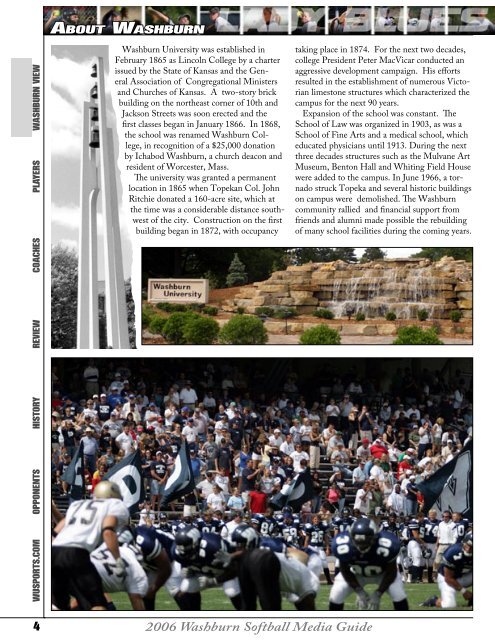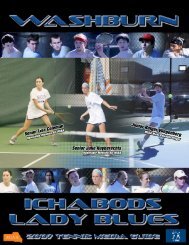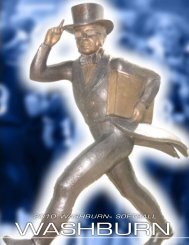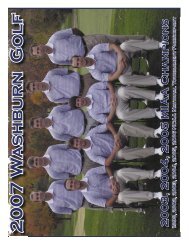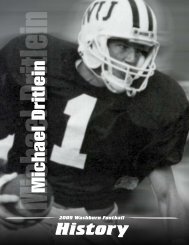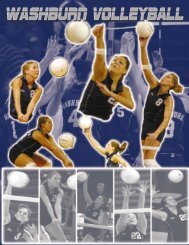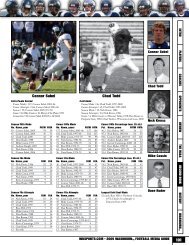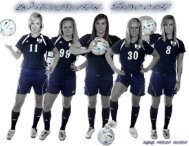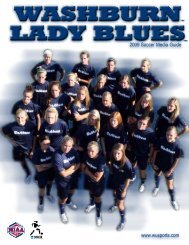WUSPORTS.COM OPPONENTS HISTORY REVIEW COACHES PLAYERS WASHBURN VIEW ABOUT WASHBURN <strong>Washburn</strong> University was established in February 1865 as Lincoln College by a charter issued by the State of Kansas and the General Association of Congregational Ministers and Churches of Kansas. A two-story brick building on the northeast corner of 10th and Jackson Streets was soon erected and the first classes began in January 1866. In 1868, the school was renamed <strong>Washburn</strong> College, in recognition of a $25,000 donation by Ichabod <strong>Washburn</strong>, a church deacon and resident of Worcester, Mass. The university was granted a permanent location in 1865 when Topekan Col. John Ritchie donated a 160-acre site, which at the time was a considerable distance southwest of the city. Construction on the first building began in 1872, with occupancy 4 <strong>2006</strong> <strong>Washburn</strong> Softball Media Guide taking place in 1874. For the next two decades, college President Peter MacVicar conducted an aggressive development campaign. His efforts resulted in the establishment of numerous Victorian limestone structures which characterized the campus for the next 90 years. Expansion of the school was constant. The School of Law was organized in 1903, as was a School of Fine Arts and a medical school, which educated physicians until 1913. During the next three decades structures such as the Mulvane Art Museum, Benton Hall and Whiting Field House were added to the campus. In June 1966, a tornado struck Topeka and several historic buildings on campus were demolished. The <strong>Washburn</strong> community rallied and financial support from friends and alumni made possible the rebuilding of many school facilities during the coming years.
Today, university facilities off er more than one million square feet of modern academic and support space. In 1941, the citizens of Topeka endorsed <strong>Washburn</strong> by voting to establish a municipal university, supported in part by the city and governed by a local board of regents. In 1952, the <strong>Washburn</strong> Board of Regents offi cially changed the name of the school to <strong>Washburn</strong> University of Topeka. In 1999, the university's primary funding was moved from city property tax to county sales tax sources, with the school retaining status as a municipal subdivision of the state. In addition to local fi nancial support, <strong>Washburn</strong> has received state funds since 1961, which have been coordinated by the Kansas Board of Regents since 1991. <strong>Washburn</strong> is governed by its own nine member Board of Regents. <strong>Washburn</strong> provides broadly-based liberal arts and professional education through more than 190 certifi cate, associate, baccalaureate, master's and juris doctor programs through the College of Arts and Sciences and the Schools of Law, Business, Nursing and Applied Studies. Ninety-seven percent of the faculty hold a doctorate or the highest degree available in their discipline. Dr. Jerry B. Farley University President Jerry Farley became the 14th President of <strong>Washburn</strong> University in 1997 following an extensive career in fi nance and business aff airs at several Oklahoma higher education institutions. Aside from a full schedule of <strong>Washburn</strong> responsibilities, Dr. Farley speaks and teaches around the United States on topics related to Higher Education Finance, Auditing, Management and Leadership. He is a C.P.A. and has been the president and chair of the board of several state and national professional organizations. He has authored or co-authored numerous articles and books on fi nance and accounting. Dr. Farley holds a degree in fi nance and accounting, an MBA, and a Ph.D. in Higher Education Administration - all from the University of Oklahoma. Serving on local and state boards has always been a priority for Dr. Farley. He is past president of the Topeka Chamber of Commerce. He has served on the board of directors of Red Cross, American Cancer Society, Boy Scouts, United Way and economic development corporations including Go Topeka. He is the recipient of awards for outstanding contributions in public service, accounting, and higher education. <strong>2006</strong> <strong>Washburn</strong> Softball Media Guide ABOUT WASHBURN Academic Majors * Denotes fields in which Secondary Education teaching certificates are available. Degrees are listed after majors (C=Certificate of Completion) # Denotes joint programs with Kaw Area Technical School Accounting, BBA, MBA Legal Studies, C, AA Addiction Counseling, C, Liberal Studies, MLS AAS, BAS Management, BBA Adult Care Home Marketing, BBA Administrator, C, BAS Mass Media, BA Allied Health C, AS, BHS Mathematics*, BA, BS Anthropology, BA Medical Imaging , BHS Art History, BA Medical Office Art*, BA, BFA Administration, C Athletic Training, BS Medical Technology, BS Banking, AAS Mental Health and Biology*, BA,BS Disabilities, AAS, BAS Business Administration, Military and Strategic MBA Studies, C Business Education, B.Ed Music Education, BM Cardiac Sonography, C Music Performance, BM Chemistry*, BA,BS Music, BA Clinical Psychology, MA Natural Science and Communication, BA Mathematics, AA Computer Information Non-Profit Management, C, Science, BS BPA (in association with Computer Information Public Administration) Systems, AA, BA, BS Nursing, BSN Correctional Administration, Office Administration C, MCJ AA # Criminal Justice, AA, BSCJ Philosophy, BA Criminal Justice, MCJ Physical Education*, BA, Curriculum and Instruction, B.Ed, BS M.Ed. Physical Therapy Assistant, Design Technology, AAS # AS Developmental Disabilities, Physics*, BA, BS AAS, BAS Political Science, BA Diagnostic Medical Pre-Dentistry Sonography, C Pre-Engineering Early Childhood Education, Pre-Law AA Pre-Medicine Early Childhood Education, Pre-Optometry B.Ed Pre-Pharmacy Economics, BA Pre-Theology Economics, BBA Pre-Veterinary Medicine Education, M.Ed. Psychology*, BA, MA Educational Administration, Public Administration, M.Ed C, BP Elementary Education, B.Ed Public Health Nursing, C English*, BA Purchasing, C, AAS # Executive Administrative Radiation Therapy, C Assistant, C Radiologic Technology, AS Finance, BBA Reading, M.Ed. Food Service, AA # Religious Studies, BA Forensic Chemical Science, Respiratory Therapy, AS BS RN Articulation, BSN French*, BA RN Refresher General Business, BBA School Nurse Certification, General Science, BS C General Sonography, C Secondary Education, M.Ed German*, BA Social Work, BSW Gerontology, AAS, BAS Social Work, MSW Health Information Sociology, BA Technology, C, AS Spanish*, BA Health Services Studio Art, BA Administration, BHS Technology Administration, History*, BA BAS Human Services, C, AAS, Theatre, BA BAS Vascular Sonography, C Humanities and Creative Victim/Survivor Services, C, and Performing Arts, AA AAS, BAS Industrial Technology, Word Processing, C AAS # Integrated Studies, BIS Interrelated Special Education, M.Ed. Law Enforcement, MCJ Law, JD Legal Office Administration, C Youth Services, AAS, BAS WASHBURN VIEW PLAYERS COACHES REVIEW HISTORY OPPONENTS WUSPORTS.COM 5


